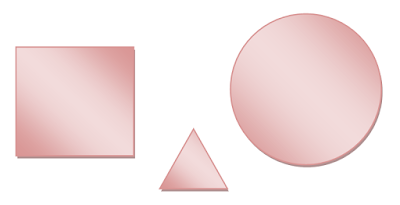Besides taste, the cigars are also rated on appearance and construction, as well as derived characteristics such as complexity and dynamics. You can find the complete rating table here.
Two elements make cigar profiling a unique rating system: the personal profile and relative rating.
The personal profile
The cigar profiling method is based on a mathematical decision making algorithm. Rather than just indicating which flavors you like, you indicate which flavors you like more or less than the others. It’s easier to compare things than to give absolute judgments, as the following example shows:
It’s easy to see that the square is much bigger than the triangle, and the circle is slightly larger than the square. It’s a lot more difficult, however, to say exactly how many square inches each shape is, just by looking at the picture. You would need to measure and calculate the exact answer. You would also need to remember from your school days how to calculate the surface of each shape.
The decision making algorithm eliminates all that. All you have to do is make pair-wise comparisons. The math behind this approach leads to highly accurate results, comparable to measuring and calculating, right down to several decimal points.
So, to create a free personal profile on the new Cigar Profiler website, you will be asked to make pair-wise comparisons of all ten basic flavor groups. That’s a bit tedious – there are 45 comparisons to make – but you will be rewarded with an accurate profile of your personal preferences at that time.
When you’re online, your personal profile is matched to the flavors observed in reviews by your fellow Cigar Profilers. You will be able to instantly assess the degree to which any cigar in the database matches your preference.
Relative rating
Most cigar rating systems are absolute: there is a rating table, points are given for each criterion, and the final score is calculated by adding all the points. The drawback of absolute rating is that it allows cigars to compensate bad characteristics with good ones. You don’t see the difference in a single score.
To solve this problem, cigar profiling scores on the various rating criteria are individually divided by the maximum value for each criterion in the database. In this way, each wrapper is compared to the smoothest wrapper in the database, each band is compared to the prettiest band, each draw to the best draw, etc. Only then are the numbers added up, resulting in a composite score that tells you exactly how good a cigar is, relative to all other cigars in the database.
The consequence of this approach is that a cigar profiler score is never stable. As soon as a better cigar enters the database, all others go down a little. This concerns very tiny adjustments in the decimal range and does not usually affect the relative ranking of the other cigars (google “rank reversal” for more on this hotly debated subject).
This may seem a little odd but so is the desire to capture the essence of a cigar in a single number. That is why the View a Cigar page of the new website is designed to present a more complete picture of a cigar than you will find anywhere. Just have a look at the wireframe below (click to enlarge) and you’ll notice qualitative data (written reviews, photos), quantitative data (scores, time-phased measurements), and relative data (percentile, rank, similar cigars), as well as basic information such as composition and production details.
You will not find more comprehensive cigar information anuwhere on the web. My ambition, as you can see at the top of the wireframe, is to build the world’s leading cigar database.


No comments:
Post a Comment